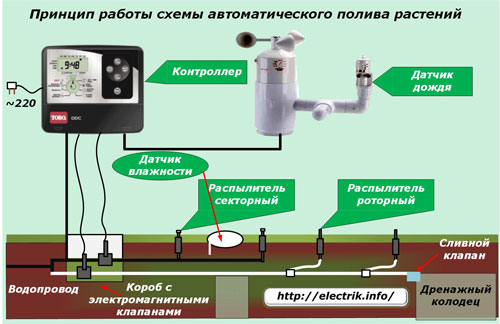Categories: Featured Articles » Home automation
Number of views: 21532
Comments on the article: 1
How modern automatic watering systems are arranged and work
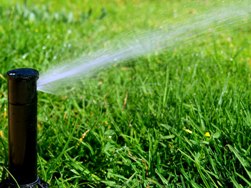 The time has come when knowledge of electricians has become necessary for people of all specialties. New technologies based on the use of electronics, microprocessor developments have firmly entered our lives and everyday life.
The time has come when knowledge of electricians has become necessary for people of all specialties. New technologies based on the use of electronics, microprocessor developments have firmly entered our lives and everyday life.
Even ordinary plant care can now be automated, entrusted to robots and automatic systems that, after setting user parameters, will maintain a microclimate, provide strictly metered watering, and create optimal conditions for growth and development.
Composition and description of the hydraulic circuit
The main elements necessary for the operation of the automatic plant watering system are shown in the picture explaining the principle of automation.
The main objective of such a system is to provide plants with the amount of water they absolutely need, taking into account the actual precipitation.
To this end, numerous scientific studies have already been carried out that provide information on the amount of moisture for the good development of plants depending on the season. For example, for the growth of lawn grass requires about 120 ÷ 150 ml of water during the summer month. When recalculated to the daily norm, the need will be 4 ÷ 5 ml. Shrubs need less.
Installed in a reference ground moisture summer resident constantly analyzes the presence of moisture in the soil, issues information to the controller, which processes it, adjusting the duration and volume of supply.
Water for irrigation is taken from the water supply, which can be:
1. connected to a centralized water supply system;
2. used individually.
At the entrance to the automatic irrigation system, a water meter and an electric pump are installed, depending on the adopted hydraulic circuit. Highways buried in the ground are equipped with check valves, which exclude the possibility of contaminated groundwater entering the system.
In order to remove water from the system before the onset of winter frosts, a drain tap is mounted. The filter removes possible contaminants that fall into the automatic irrigation system before the distribution of water along the outgoing lines. It ensures the normal operation of solenoid valves.
In complex, branched systems at the inlet, the main valve of a special design of an electromagnetic type is installed, equipped with protection against water hammer with the possibility of controlling it from the controller. In country and home irrigation, it is practically not used.
Controlled solenoid valves are mounted in plastic housings inside the soil in the center of the lines. Their number depends on the branching structure, its application in a particular area.
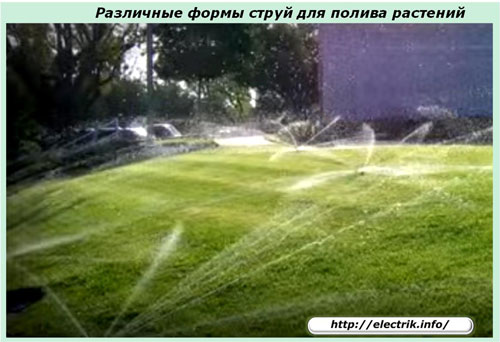
Inside the lines of an automatic irrigation system, water pressure is always maintained. Pipelines, adapters, fittings, installation methods must reliably withstand it, eliminate leaks. Therefore, special designs of polyethylene pipes are used that can withstand a pressure of 10 bar inside them.
Water delivery to the irrigation zone is regulated by electromagnetic valves located in special boxes with various types of spray guns, including a drip irrigation system. They are united by work zones.
Each zone is created for the work of the same type of spray groups, the most suitable for the development of certain types of plants and is included in the work from the controller in turn. Simultaneous watering of the soil from all highways is not applied.
A gearbox is installed inside the drip irrigation system. It maintains the optimum allowable water pressure in the system to form droplets.
Automatic drain valves at the end of highways exclude the formation of increased soil moisture, contribute to its drainage when the system is turned on.
The location for the location of the controller is chosen taking into account the ease of maintenance, access, and environmental protection. You can also use a special airtight box, designed for outdoor use.
It is connected to an electric power supply network and electromagnetic valves, rain sensors with special moisture-resistant cables and wires. For mounting the ends of the wires in the boxes of the irrigation system, universal silicone fillers are used to prevent moisture from penetrating metal parts.
The power supply to the controller is usually carried out from a household network 220 through an integrated power supply. For small systems, batteries or rechargeable batteries are acceptable.
The controller controls the operation of the rain sensor allows you to stop watering during precipitation, to prevent its overmoistening.
The main parts of the automatic irrigation system
These include:
-
Control block;
-
rain sensors;
-
controlled solenoid valves;
-
sprayers;
-
Filters
-
automatic drain tap;
-
pipelines and fittings;
-
drip pipes;
-
hydraulic drip irrigation gear;
-
micro sprayers.
Water source
If there is an individual source of water. then you can make a tank or buy a large tank. It should collect rainwater during precipitation or pump water from a nearby pond or well. At the same time, its temperature will be heated from the surrounding air. This will have a positive effect on the growth of certain plant species.
To fill the tank you will need a pump with an automatic control unit that controls the upper and lower levels of water filling.
If you water the plants from a centralized water supply, you should take into account the presence of impurities of bleach in the water, which can have an adverse effect on the development of many types of flowers, heat-loving vegetables.
When water is supplied from a drilled well, the technical characteristics of the pump should be correctly selected for the needs of the system performance. You should also install filters, taking into account their throughput, service capabilities.
Before starting the design of an automatic irrigation system, it is important to analyze the power of the water supply source with the needs of the water flow rate, compare them when creating different pressures in the mains, and provide the necessary reserve.
Control block
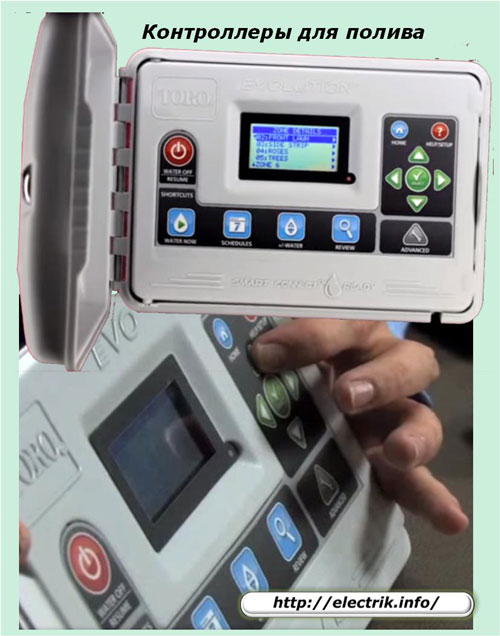
For automatic irrigation systems release microcontrollershaving a different number of management and control functions. They allow you to pre-set the operating mode for a certain period of operation.
Controllers with a digital interface simplify the programming process by irrigation, have small dimensions, are designed to work with irrigation systems of different configurations.
Useful features of digital microcontrollers include:
-
the availability of various irrigation system startup programs;
-
application of different work schedules, seasonally adjusted;
-
regulation and limitation of irrigation duration with ensuring delays between switching on of various modes;
-
the ability to enter and store parameters of the programmed manual operation mode in the controller memory;
-
setting and saving program settings when using additional battery power;
-
convenience of viewing the entered settings;
-
prescribed algorithm of actions in case of power failure;
-
compliance with current standards for electronic devices;
-
the ability to connect external sensors of popular manufacturers, including wireless models for controlling frost and rain sensors;
-
built-in diagnostics of electrical connections;
-
preview functions.
To power the solenoid valves, most often the controllers emit a voltage of 24 volts.
Rain sensors
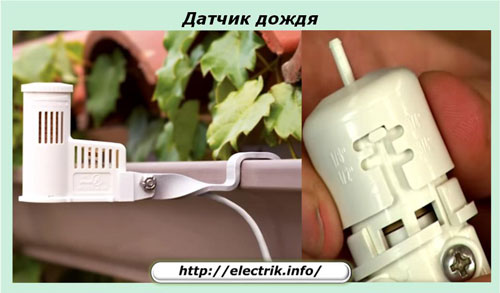
They are created to automatically exclude watering during precipitation. They allow you to:
-
to exclude waterlogging of plants due to excessive irrigation in wet weather;
-
save water consumption of at least 30% from the source of water supply, equipment resource.
Rain sensors can be wired or work on a radio channel. For climatic conditions with the possibility of frost, they can be supplemented with frost sensors. Their cases are mounted on building structures or special brackets.
Wired models are connected with a moisture-resistant electrical cable using brackets or couplings.
Wireless devices are equipped with:
-
multifunctional receiving device;
-
LCD display
-
signal indicators.
They provide:
-
planned delays in resuming irrigation to ensure water saving regimes;
-
the use of a system that allows you to disable or enable the sensor for automatic operation at any time;
-
indication of modes;
-
sensitivity mode selection;
-
ease of installation.
Solenoid valves
Various types of solenoid valve devices are designed for remote control of water spray during irrigation by changing the hydraulic resistance of the flow by the position of the valve controlled by the solenoid.
For connection to pipelines, a threaded connection or screw clamps are used. Preference should be given to designs that provide fast, reliable assembly and removal from the circuit for convenient maintenance during operation.
High-quality valve bodies are made of high-strength grades of polypropylene with the addition of fiberglass and stainless steel elements, which are highly resistant to corrosion and ultraviolet.
Elite models are equipped with:
-
a smooth closing device that eliminates the occurrence of water hammer in the system;
-
a jet regulating the flow rate taking into account the influence of thermal expansion of the medium;
-
a membrane of increased strength and a sealing system that ensures durability and tightness;
-
manual control handle;
-
flow measurement system and its control device.
Popular specifications:
-
working pressure in Bar;
-
productivity in l / min;
-
thread types for external and internal connection;
-
electrical supply of the solenoid coil in volts with a holding and starting current in amperes.
Spray guns
When squeezing a stream of water through the holes of the nozzle located at the end of the sprayer (sprinkler), a cloud of small drops or a jet is created, which is sprayed at a certain distance.
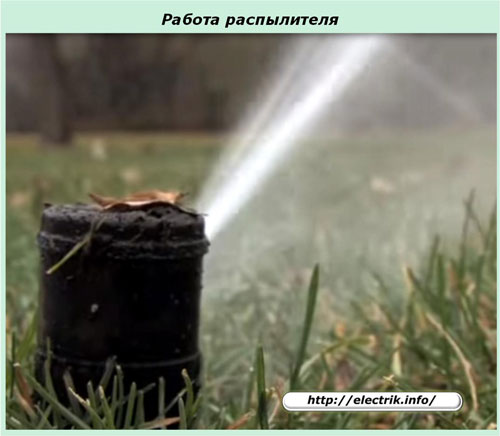
The sprayer housing can be monolithic or with a sliding movable part to increase the spray range, and the number of nozzles is from one to ten or a little more.
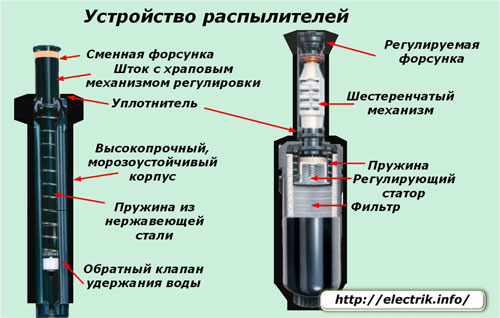
Structurally, sprayers are created according to two types of water supply:
1. sectorial, when the flow is directed under simple pressure;
2. rotary, using twisting, turbulence of the jet according to the centrifugal principle.
In the first case, the cloud range reaches up to five meters, and the angle of dispersion of the jet through the nozzle depends on its design and can range from 40 to 360 angular degrees. There are designs with an adjustable dispersion angle and even range, which allow efficiently irrigating rectangular areas.
Rotary atomizers are created with:
1. by extending the nozzle mechanism from the housing - modification “pop up”;
2. without extension - “shrub”.
The retractable mechanism allows you to control the spray range, more efficiently handle the territory of a complicated configuration.
The multi-jet rotation of the sprayed stream allows moisture to penetrate better inside the soil even in solid formulations, which eliminates the drainage of moisture on the slopes. To create a uniform cloud, nozzles are strictly selected and the flow is rotated by sector disks.
Filters
The internal cavities of the hydraulic lines must be clean. Any mechanical particles trapped inside may interfere with the operation of solenoid valves or nozzles. The use of high-quality filters allows you to remove impurities, purify water, and ensure a long service life of the equipment.
To clean the system of fine sand, special filter designs are used.
Drain valve
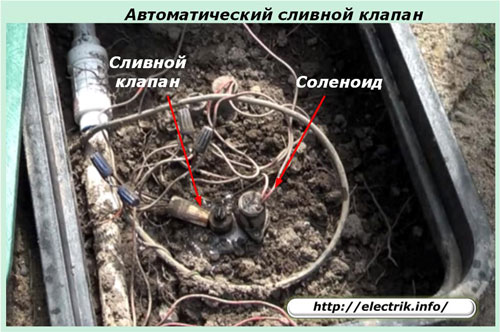
Used to remove moisture from the line when it is inoperative - to drain the system.
When creating pressure in the hydraulic circuit, the valve membrane closes the drain hole, completely blocking it, ensuring the tightness of the end of the line. When the pump stops working, the return spring will force the valve back, opening the drain to remove water from the system.
Simultaneous operation of several drain valves can create a water hammer that will affect the operation of electromagnets. I avoid such cases at the stage of system design by installing one valve for the current zone.
Piping and fittings
Automatic irrigation systems work better on polyethylene pipes designed to withstand pressure from 6 to 10 bar with outer diameters from 25 to 110 mm, which are selected according to system performance.
Their connection is performed by compression fittings or welding. It is also allowed to connect metal and plastic housings and fittings with sealing threaded joints with Teflon tape.
Drip pipes

They are used to provide drip irrigation of vegetables, shrubs, garden trees, locating drip systems at distances of 20 ÷ 50 cm in the form of a labyrinth of small pipes located on the surface of the soil without being buried in the ground.
The drip pipe allows you to moisten the surface with a speed of the order of 1 ÷ 4 liters per hour at a system pressure of 1.5 bar.
There are drip pipe designs treated with special chemicals. They protect the trunk from the penetration of the roots into the holes and can be placed inside the soil.
Hydraulic gear drip irrigation
Designed to reduce pressure from the pump operating value to 1.5 bar. For systems using only drip irrigation without sprayers, a hydraulic gearbox is not used.
Micro sprayers
Use in places with a limited area of diameter from 0.5 to 5 m. Effectively work on flower beds, flower beds, shrubs, solid soil.

The automatic watering system allows you to create favorable conditions for the development of plants, eliminates the need for a long daily routine to take care of the garden, lawn, garden, cottage.
Its use allows you to:
-
to grow healthy, well-groomed plants in the country;
-
create a beautiful lawn;
-
provide uniform watering without direct human involvement;
-
save water consumption.
See also at bgv.electricianexp.com
:

